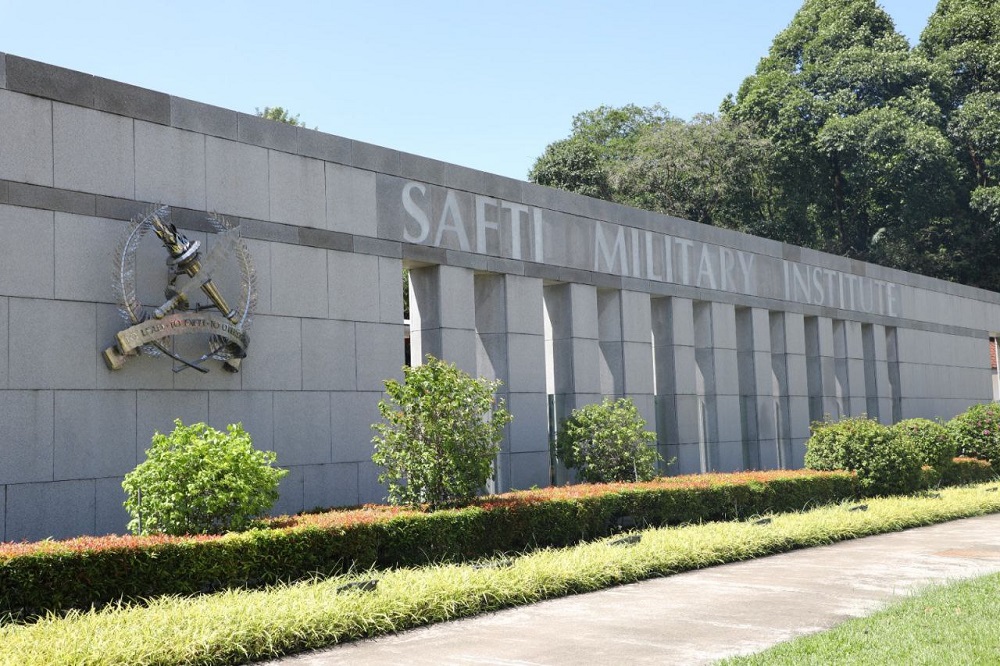History of SAFTI MI
SAFTI Military Institute (SAFTI MI) derives its name from the former Singapore Armed Forces Training Institute (SAFTI) that was established on 14 Feb 1966 at Pasir Laba Camp.
The retention of the term ‘SAFTI’, no longer as an acronym but as a name in itself for the Military Institute, reflects our close links with the old SAFTI. Our traditions of excellence, discipline and tough training started there, and they remain today, as part of our heritage.
The old SAFTI had many commendable and distinct goals, all conceived and designed to build and forge a modern, strong and capable SAF. However, by the 1980s, as the SAF expanded rapidly, SAFTI’s training facilities were no longer sufficient to cope with the increasing demands of officer training. At the same time, as the SAF came of age, there was a growing recognition of the need for greater integration in the training of officers across the SAF Services. Hence, SAFTI MI was set up and officially opening on 25 Aug 1995.
Milestones
| 14 Feb 1966 |
Establishment of Singapore Armed Forces Training Institute (SAFTI) and the commencement of the first Instructor’s Preparatory Course, where a total of 60 hand-picked Officers and Non-Commissioned Officers (NCOs) attended the course to become instructors of SAFTI. |
| 18 Jun 1966 | Official opening of SAFTI at Pasir Laba Camp by Dr Goh Keng Swee, who also presented SAFTI’s formation sign, the “Sword and Torch”. |
| 18 Nov 1966 | First batch of 150 regular Section Commanders graduated in SAFTI. |
| 16 Jul 1967 | First ever commissioning parade for the first batch of Officer Cadets with 117 graduates. |
| 16 Jun 1968 | Presentation of SAFTI Colours by then-Prime Minister Mr Lee Kuan Yew to recognize SAFTI’s progress and significant role in training SAF Military leaders. |
| 17 Dec 1968 | School of Advanced Training for Officers (SATO) was established. |
| Early 1982 | Then-Prime Minister Mr Lee Kuan Yew first mooted the idea of a Tri-Service Military Institute. Acquisition of land by MINDEF from Hokkien Huay Kuan took place to pursue Mr Lee’s idea. |
| 14 Nov 1987 | Construction of SAFTI MI was publicly announced by BG (NS) Lee Hsien Loong (then-Minister for Trade and Industry, and Second Minister for Defence) at the Commissioning Parade at Officer Cadet School (Pasir Laba Camp). |
| 9 Jun 1990 | Ground Breaking Ceremony for new SAFTI MI at Upper Jurong Road (present location) was officiated by then-Prime Minister Mr Lee Kuan Yew. |
| 27 Oct 1992 | Foundation Stone Ceremony officiated by then-Minister for Defence Dr Yeo Ning Hong. |
| 25 Mar 1994 | Topping-Out Ceremony officiated by then-DPM BG (NS) Lee Hsien Loong. |
| 1995 | Relocation of SAFTI MI from Pasir Laba Camp to present location. |
| Jun 1995 | Singapore Command and Staff College (SCSC) moved to SAFTI MI from Seletar Camp. |
| 25 Aug 1995 | SAFTI MI’s Opening Ceremony was officiated by then-Prime Minister Goh Chok Tong, who also presented the new Colours to SAFTI MI. |
| 1 Feb 2011 | Singapore Command and Staff College (SCSC) was renamed as the Goh Keng Swee Command and Staff College (GKS CSC), in honour of the late Dr Goh Keng Swee, who set the foundations for a strong SAF. |
| 25 Feb 2014 | Transfer of Command of SWI from HQ 9th Division / Infantry to SAFTI MI. |
Present SAFTI MI

Today, SAFTI MI conducts courses for the education and training of our SAF leaders. It comprises buildings equipped with state-of-the-art facilities incorporating the latest in office and building automation.
The education and training of leaders are done at three main levels as represented by the Goh Keng Swee Command and Staff College, the SAF Advanced Schools, the Officer Cadet School, and the Specialist and Warrant Officer Institute. These schools had different beginnings at different locations, but they now function as part of a cohesive and unified whole within SAFTI MI. SAFTI MI therefore mirrors the SAF’s progress in getting our leaders to think and to operate jointly. Closely supporting the schools in their education and training missions are the Institute for Military Learning, the SAF Centre for Leadership Development, the Centre for Learning Systems and the SAF Education Office.